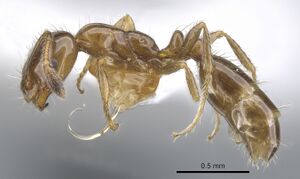Monomorium iyenasu
| Monomorium iyenasu | |
|---|---|

| |
| Scientific classification | |
| Kingdom: | Animalia |
| Phylum: | Arthropoda |
| Class: | Insecta |
| Order: | Hymenoptera |
| Family: | Formicidae |
| Subfamily: | Myrmicinae |
| Tribe: | Solenopsidini |
| Genus: | Monomorium |
| Species: | M. iyenasu |
| Binomial name | |
| Monomorium iyenasu Bolton, 1987 | |
A collection of this species was taken from a soil nest in rainforest.
Identification
Bolton (1987) - The only member of the M. iyenasu complex in the M. monomorium species group. Perhaps the most easily recognized species of this group in the Afrotropical region, iyenasu lacks obvious relatives and appears out of place as regards the remainder of the regional Monomorium fauna. The combination of large size, short scapes, dense pilosity, relatively small eyes and large propodeal spiracle render iyenasu immediately recognizable.
Keys including this Species
Distribution
Latitudinal Distribution Pattern
Latitudinal Range: 0.35556° to -0.317°.
| North Temperate |
North Subtropical |
Tropical | South Subtropical |
South Temperate |
- Source: AntMaps
Distribution based on Regional Taxon Lists
Afrotropical Region: Kenya, United Republic of Tanzania.
Distribution based on AntMaps
Distribution based on AntWeb specimens
Check data from AntWeb
Countries Occupied
| Number of countries occupied by this species based on AntWiki Regional Taxon Lists. In general, fewer countries occupied indicates a narrower range, while more countries indicates a more widespread species. |

|
Estimated Abundance
| Relative abundance based on number of AntMaps records per species (this species within the purple bar). Fewer records (to the left) indicates a less abundant/encountered species while more records (to the right) indicates more abundant/encountered species. |

|
Biology
Castes
Worker
Images from AntWeb
   
| |
| Worker. Specimen code casent0902256. Photographer Will Ericson, uploaded by California Academy of Sciences. | Owned by NHMUK, London, UK. |
    
| |
| Syntype of Monomorium iyenasu. Worker. Specimen code casent0902255. Photographer Will Ericson, uploaded by California Academy of Sciences. | Owned by NHMUK, London, UK. |
Nomenclature
The following information is derived from Barry Bolton's Online Catalogue of the Ants of the World.
- iyenasu. Monomorium iyenasu Bolton, 1987: 394 (w.) TANZANIA.
- Type-material: 3 syntype workers.
- [Note: the 3 syntypes are all badly damaged, mounted on a single pin.]
- Type-locality: Tanzania: Shinyanga (O.W. Richards).
- Type-depository: BMNH.
- Status as species: Bolton, 1995b: 263; Hita Garcia, et al. 2013: 212.
- Distribution: Kenya, Tanzania.
Unless otherwise noted the text for the remainder of this section is reported from the publication that includes the original description.
Description
Worker
Syntype. TL ca. 3.5, HL 0.84-0.86, HW 0.72-0.74, CI 86, SL 0.54, SI 73-75, PW 0.46-0.52, AL 0.94-1.02 (3 measured).
Clypeal carinae weakly developed and only poorly defined, widely divergent anteriorly. Prominent median portion of clypeus with its anterior margin strongly concave, the concavity bounded on each side by a blunt obtusely angled projection of the margin. Eyes relatively small, 0.19 x HW and with 8-9 ommatidia in the longest row. In full-face view the eyes distinctly in front of the midlength of the sides but their posterior margins close to the midlength. Antennal scapes relatively short (SI < 80), when laid straight back from their insertions conspicuously failing to reach the occipital margin. Sides of head shallowly convex, converging anteriorly in front of the eyes and posteriorly behind them in full-face view. Occipital margin broadly but shallowly concave across almost its entire width. With the head in profile the outline biconvex, the ventral surface somewhat more strongly convex than the dorsum, the deepest point of the head occurring just behind the level of the eye. Promesonotal dorsum evenly convex, on a much higher level than the propodeum, and sloping posteriorly to the narrowly but deeply impressed metanotal groove. Metanotal cross-ribs strong and conspicuous both dorsally and laterally. Propodeal spiracle large and dominating the side of the sclerite. Propodeal dorsum sloping steeply posteriorly, rounding bluntly into the near-vertical declivity. Petiole node high and subconical in profile, narrowly rounded above. Subpetiolar process a narrow anteroventral rim or strip below the peduncle. Postpetiole much more broadly rounded dorsally than petiole in profile, somewhat anteroposteriorly compressed and lower than the petiole. All dorsal surfaces of head and body very densely hairy, the promesonotum with 20 or so pairs of standing hairs. Head dorsally with numerous conspicuous hair-pits. Remainder of body with less obvious hair-pits dorsally but otherwise unsculptured except for the metanotal cross-ribs and some faint metapleural striation. Colour predominantly yellowish brown, the cephalic dorsum and apical half of the gaster darker in shade than the remainder. In two of the syntypes the propodeal dorsum is as dark as the head.
Type Material
Syntype workers, Tanzania: Shinyanga, no further data (O. W. Richards) (The Natural History Museum).
This very distinctive species is described from three damaged workers, mounted on a single pin. The upper and middle specimens are lacking the post-petiole and gaster, the lower specimen is lacking its head. Because of this damage the three have been described collectively and are treated as a syntypic series.

